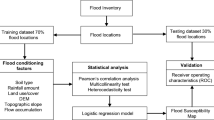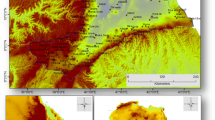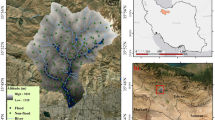Abstract
This work integrates topographic slope with other geo-environmental flood-causing factors in order to improve the accuracy of flood prediction and susceptibility mapping using logistic regression (LR) model. The work was done for the eastern Jeddah watersheds in Saudi Arabia, where flash floods constitute a danger. A geospatial dataset with 140 historical flood records and twelve geo-environmental flood-causing factors was constructed. A number of significant statistical methods were also applied to provide reliable flood prediction and susceptibility mapping, including Jarque–Bera, Pearson’s correlation, multicollinearity, heteroscedasticity, and heterogeneity analyses. The results of the models are validated using the area under curve (AUC) and other seven statistical measures. These statistical measures include accuracy (ACC), sensitivity (SST), specificity (SPF), negative predictive value (NPV), positive predictive value (PPV), root-mean-square error (RMSE), and Cohn’s Kappa (K). Results showed that both in training and testing datasets, the LR model with the slope as a moderating variable (LR-SMV) outperformed the classical LR model. For both models (LR and LR-SMV), the adjusted R2 is 88.9 and 89.2%, respectively. The majority of the flood-causing factors in the LR-SMV model had lower Sig. R values than in the LR model. As compared to the LR model, the LR-SMV attained the highest values of PPV (90%), NPV (93%), SST (92%), SPF (90%), ACC (89%), and K (81%), for both training and testing data. Moreover, employing slope as a moderating variable demonstrated its viability and reliability for defining precisely flood-susceptibility zones in order to reduce flood risks.












Similar content being viewed by others
Data availability
Not applicable.
References
Abdelkarim A, Gaber AFD (2019) Flood risk assessment of the Wadi nu’man basin, Mecca, Saudi Arabia (during the period, 1988–2019) based on the integration of geomatics and hydraulic modeling: a case study. Water 11(9):1887. https://doi.org/10.3390/w11091887
Al-Juaidi AE, Nassar M, Al-Juaidi OE (2018) Evaluation of flood susceptibility mapping using logistic regression and GIS conditioning factors. Arab J Geosci 11:765
Al-Juaidi AE (2018) A simplified GIS based SCS-CN method for the assessment of land use change on runoff. Arab J Geosci 11:269
Al-Juaidi AEM (2020) The effectiveness of urban water conservation and desalination for water resources management in Jeddah City. Desalin Water Treat 208:196–209
Al-Juaidi AEM, Al-Shotairy AS (2020) Evaluation of municipal water supply system options using water evaluation and Planning System (WEAP): Jeddah case study. Desalin Water Treat 176:317–323
Al-Juaidi AEM, Attia AS (2020) Evaluation of desalination and groundwater supply sources for future water resources management in Riyadh city. Desalin Water Treat 175:11–23
Alexander D (1993) Natural disasters. UCL Press, London, p 631
Al Saud MM (2015) Flood control management for the city and surroundings of Jeddah, Saudi Arabia; Springer: New York, NY, USA; London, UK pp. 1–169
Al-Shutayri AS, Al-Juaidi AE (2019) Assessment of future urban water resources supply and demand for Jeddah City based on the WEAP model. Arab J Geosci 12:431
Arabameri A, Rezaei K, Cerdà A, Conoscenti C, Kalantari Z (2019) A comparison of statistical methods and multi-criteria decision making to map flood hazard susceptibility in Northern Iran. Sci Total Environ 660:443–458
Bellu A, Fernandes LFS, Cortes RM, Pacheco FA (2016) A framework model for the dimensioning and allocation of a detention basin system: the case of a flood-prone mountainous watershed. J Hydrol. 533:567–580
Beven KJ, Kirkby NJ (1979) A physically based variable contributing area model of basin hydrology. Hydrol Sci Bull 24:43–69
Billa L, Shattri M, Rodzi Mahmud A, Halim Ghazali A (2006) Comprehensive planning and the role of SDSS in flood disaster management in Malaysia. Disaster Prev Manag: Int J 15(2):233–240
Bui DT, Ngo PTT, Pham TD, Jaafari A, Minh NQ, Hoa PV, Samui P (2019) A novel hybrid approach based on a swarm intelligence optimized extreme learning machine for flash flood susceptibility mapping. CATENA 179:184–196
Bui Q, Nguyen Q, Nguyen XL, Pham VD, Nguyen HD, Pham V (2020) Verification of novel integrations of swarm intelligence algorithms into deep learning neural network for flood susceptibility mapping. J Hydrol 581:124379
Burrough PA, McDonnell RA (1998) Principles of geographical information systems. Oxford University Press, New York
Choubin B, Moradi E, Golshan M, Adamowski J, Sajedi-Hosseini F, Mosavi A (2019) An ensemble prediction of flood susceptibility using multivariate discriminant analysis, classification and regression trees, and support vector machines. Sci Total Environ 651:2087–2096
Dano U (2020) Flash flood impact assessment in Jeddah City: an analytic hierarchy process approach. Hydrology 7(1):10
Das S (2020) Flood susceptibility mapping of the Western Ghat coastal belt using multi-source geospatial data and analytical hierarchy process (AHP). Remote Sens Appl: Soc Environ 20:100379
De Moel H, Aerts J (2010) Effect of uncertainty in land use, damage models and inundation depth on flood damage estimates. Nat Hazards 58(1):407–425
De Rosa P, Fredduzzi A, Cencetti C (2019) Stream power determination in GIS: an index to evaluate the most ’sensitive’ points of a river. Water 11:1145. https://doi.org/10.3390/w11061145
Dormann CF, Elith J, Bacher S, Buchmann C, Carl G, Carré G, Marquéz JRG, Gruber B, Lafourcade B, Leitão PJ (2013) Collinearity: a review of methods to deal with it and a simulation study evaluating their performance. Ecography 36(1):27–46
Dou X, Song J, Wang L, Tang B, Xu S, Kong F, Jiang X (2017) Flood risk assessment and mapping based on a modified multi-parameter flood hazard index model in the Guanzhong Urban Area, China. Stoch Env Res Risk Assess 32(4):1131–1146
El-Haddad B, Youssef A, Pourghasemi H, Pradhan B, El-Shater A, El-Khashab (2020) Flood susceptibility prediction using four machine learning techniques and comparison of their performance at Wadi Qena Basin, Egypt. Nat Hazard 105(1):83–114
EU-Directive (2007) Directive 2007/60/EC of the European Parliament and of the Council of 23 October 2007 on the assessment and management of flood risks. Off J Eur Union 288:27–33
Gujarati DN (2004) Basic econometrics, New Delhi: Tata McGraw-Hill, 4th Edition
Helsel DR, Hirsch RM, Ryberg KR, Archfield SA, Gilroy EJ (2020) Statistical methods in water resources: Chapter 3 of section A, statistical analysis; book 4, Hydrologic Analysis and interpretation. Reston, VA: U.S. Department of the Interior, U.S. Geological Survey. https://doi.org/10.3133/tm4A3
Hoehler FK (2000) Bias and prevalence effects on kappa viewed in terms of sensitivity and specificity. J Clin Epidemiol 53(5):499–503
Huber PJ (1967) The behavior of maximum likelihood estimates under nonstandard conditions. Proceedings of the Fifth Berkeley Symposium on Mathematical Statistics and Probability, pp 221–233
Jaafari A, Panahi M, Pham B, Shahabi H, Bui D, Rezaie F, Lee S (2019) Meta optimization of an adaptive neuro-fuzzy inference system with grey wolf optimizer and biogeography-based optimization algorithms for spatial prediction of landslide susceptibility. CATENA 175:430–445
Janizadeh S, Avand M, Jaafari A, Phong T, Bayat M, Ahmadisharaf E, Prakash I, Pham B, Lee S (2019) Prediction success of machine learning methods for flash flood susceptibility mapping in the Tafresh Watershed, Iran. Sustainability 11(19):5426
Jarque C, Bera M, Anil K (1987) A test for normality of observations and regression residuals. Int Stat Rev 55(2):163–172
Kalantar B, Ueda N, Saeidi V, Janizadeh S, Shabani F, Ahmadi K (2021) Shabani F (2021) Deep neural network utilizing remote sensing datasets for flood hazard susceptibility mapping in Brisbane, Australia. Remote Sens 13:2638
Khosravi K, Pourghasemi H, Chapi K, Bahri, M (2016) Flash flood susceptibility analysis and its mapping using different bivariate models in Iran: a comparison between Shannon’s entropy, statistical index, and weighting factor models. Environ Monit Assess 866 188(12)
Khosravi K, Pham BT, Chapi K, Shirzadi A, Shahabi H, Revhaug I, Prakash I, Tien Bui DT (2018) A comparative assessment of decision trees algorithms for flash flood susceptibility modeling at Haraz Watershed, Northern Iran. Sci Total Environ 627:744–755
Khosravi K, Shahabi H, Pham BT, Adamowski J, Shirzadi A, Pradhan B, Dou J, Ly HB, Gróf G, Ho HL, Hong H, Chapi K, Prakash I (2019) A comparative assessment of flood susceptibility modeling using multi-criteria decision-making analysis and machine learning methods. J Hydrol 573:311–323
Kia MB, Pirasteh S, Pradhan B, Mahmud AR, Sulaiman WNA, Moradi A (2012) An artificial neural network model for flood simulation using GIS: Johor River Basin. Malaysia Environ Earth Sci 67(1):251–264
Landis JR, Koch, GG (1977) The measurement of observer agreement for categorical data. Biometrics 159–174
Liuzzo L, Sammartano V, Freni G (2019) Comparison between different distributed methods for flood susceptibility mapping. Water Resour Manag 33(9):3155–3173
Menard S (2001) Applied logistic regression analysis, 2nd edn. Sage Publication, Thousand Oaks, CA, USA, pp 1–101
Merwade V (2012) Creating SCS curve number grid using HEC-GeoHMS. Available at https://www.researchgate.net/publication/228757776_Creating_SCS_Curve_Number_Grid_using_HEC-GeoHMS. Accessed 20 Jul 2022
Mojaddadi H, Pradhan B, Nampak H, Ahmad N, Ghazali AH (2017) Ensemble machine-learning based geospatial approach for flood risk assessment using multisensory remote-sensing data and GIS. Geomat Nat Haz Risk 1–23
Mudashiru RB, Sabtu N, Abstan I (2021) Quantitative and semi-quantitative methods in flood hazard/susceptibility mapping: a review. Arab J Geosci 14:941
Mukaka MM (2012) A guide to appropriate use of correlation coefficient in medical research. Malawi Med J 24(3):69–71
Mosavi A, Ozturk P, Chau KW (2018) Flood prediction using machine learning models: literature review. Water 10:1536
Muñoz P, Orellana-Alvear J, Willems P, Célleri R (2018) Flash-flood forecasting in an Andean Mountain catchment—development of a step-wise methodology based on the random forest algorithm. Water 10:1519
Nachappa TG, Piralilou ST, Gholamnia K, Ghorbanzadeh O, Rahmati O, Blaschke T (2020) Flood susceptibility mapping with machine learning, multi-criteria decision analysis and ensemble using Dempster Shafer Theory. J Hydrol 590:125275
Papadopoulou-Vrynioti K, Bathrellos GD, Skilodimou HD, Kaviris G, Makropoulos K (2013) Karst collapse susceptibility mapping considering peak ground acceleration in a rapidly growing urban area. Eng Geol 158:77–88
Park S, Hamm S, Kim J (2019) Performance evaluation of the GIS-based data-mining techniques decision tree, random forest, and rotation forest for landslide susceptibility modeling. Sustainability 11:5659
Pham B, Phong T, Nguyen H, Qi C, Al-Ansari N, Amini A, Ho L, Tuyen T, Yen H, Ly H, Prakash I, Tien Bui D (2020) A comparative study of Kernel logistic regression, radial basis function classifier, multinomial Naïve Bayes, and logistic model tree for flash flood susceptibility mapping. Water 12(1):239
Pradhan B (2010) Flood susceptible mapping and risk area delineation using logistic regression, GIS and remote sensing. J Spat Hydrol 9(2):1–18
Rahmati O, Pourghasemi HR, Zeinivand H (2016) Flood susceptibility mapping using frequency ratio and weights-of-evidence models in the Golastan Province. Iran Geocarto Int 31:42–70
Sahana M, Patel P (2019) A comparison of frequency ratio and fuzzy logic models for flood susceptibility assessment of the lower Kosi River Basin in India. Environ Earth Sci 78 (10)
Samanta RK, Bhunia GS, Shit PK, Pourghasemi HR (2018) Flood susceptibility mapping using geospatial frequency ratio technique: a case study of Subarnarekha River basin, India. Model Earth Syst Environ 4:395–408
Soil Conservation Service, United States Department of Agriculture (SCS-USDA) (1986) Urban hydrology for small watersheds. Technical Release No. 55. (TR-55), Washington DC
Souissi D, Zouhri L, Hammami S, Msaddek M, Zghibi A, Dlala M (2019) GIS-based MCDM – 944 AHP modeling for flood susceptibility mapping of arid areas, southeastern Tunisia. Geocarto Int 35(9):991–1017
Tarboton DG, Bras RL, Rodriguez-Iturbe I (1992) A physical basis for drainage density. Geomorphology 5:55–76
Tehrany M, Jones S, Shabani F (2019) Identifying the essential flood conditioning factors for flood prone area mapping using machine learning techniques. CATENA 175:174–192
Wang Z, Hong H, Chen W, Li S, Panahi M, Khosravi K, Shirzadi A, Shababi H, Panahi S, Costache R (2019) Flood susceptibility mapping in Dingnan County (China) using adaptive neuro-fuzzy inference system with biogeography based optimization and imperialistic competitive algorithm. J Environ Manag 247:712–729
White H (1980) A heteroskedasticity-consistent covariance matrix estimator and a direct test for heteroskedasticity. Econometrica 48(4):817
Woodrow K, Lindsay JB, Berg AA (2016) Evaluating DEM conditioning techniques, elevation source data, and grid resolution for field-scale hydrological parameter extraction. J Hydrol 540:1022–1029
Xu H, Deng Y (2018) Dependent evidence combination based on Shearman coefficient and Pearson coefficient. IEEE Access 6:11634–11640
Youssef A, Pradhan B, Sefry S (2016) Flash flood susceptibility assessment in Jeddah city (Kingdom of Saudi Arabia) using bivariate and multivariate statistical models. Environ Earth Sci 75(1)
Funding
The project was funded by the Deanship of Scientific Research (DSR) at King Abdulaziz University, Jeddah, under grant no. (D-460-135-1441). The author, therefore acknowledge with thanks DSR for technical and financial support.
Author information
Authors and Affiliations
Contributions
Not applicable.
Corresponding author
Ethics declarations
Ethics approval
Yes.
Consent to participate
Not applicable.
Consent for publication
Not applicable.
Conflict of interest
The author declares no competing interests.
Additional information
Responsible Editor: Philippe Garrigues
Publisher's note
Springer Nature remains neutral with regard to jurisdictional claims in published maps and institutional affiliations.
Rights and permissions
Springer Nature or its licensor (e.g. a society or other partner) holds exclusive rights to this article under a publishing agreement with the author(s) or other rightsholder(s); author self-archiving of the accepted manuscript version of this article is solely governed by the terms of such publishing agreement and applicable law.
About this article
Cite this article
Al-Juaidi, A.E.M. The interaction of topographic slope with various geo-environmental flood-causing factors on flood prediction and susceptibility mapping. Environ Sci Pollut Res 30, 59327–59348 (2023). https://doi.org/10.1007/s11356-023-26616-y
Received:
Accepted:
Published:
Issue Date:
DOI: https://doi.org/10.1007/s11356-023-26616-y




